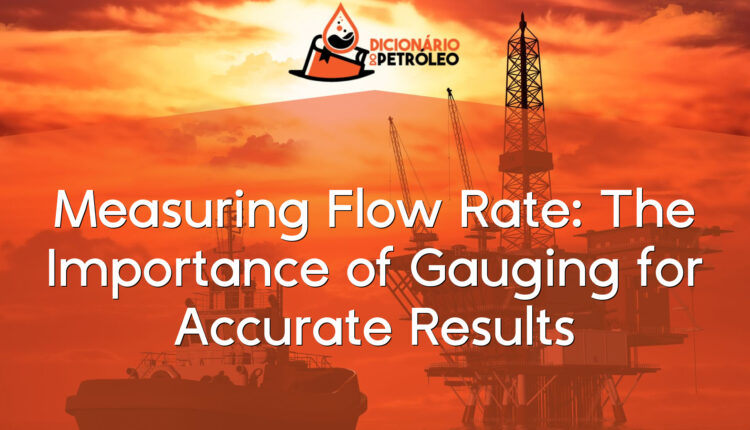Measuring Flow Rate: The Importance of Gauging for Accurate Results
No mercado do petróleo, a medição precisa da taxa de fluxo é essencial para garantir resultados confiáveis e precisos. A falta de uma medição adequada pode levar a erros significativos na determinação da quantidade de petróleo produzido, transportado ou armazenado, o que pode ter impactos financeiros significativos. Neste artigo, discutiremos a importância da medição precisa da taxa de fluxo e como isso pode ser alcançado por meio do uso de medidores de fluxo confiáveis e precisos. Leia mais para descobrir como medir a taxa de fluxo pode ajudar a garantir resultados precisos e acertar em suas análises no mercado do petróleo.
Dicas para medir a taxa de fluxo com precisão e confiabilidade
| Descubra como medir a taxa de fluxo de forma precisa e confiável | Leia nosso artigo sobre a importância da medição para resultados precisos | Acerte em suas análises |
|---|---|---|
| 1. Escolha o dispositivo de medição correto para a aplicação | 1.1 Entenda a importância da medição precisa para resultados confiáveis | 1.2 Utilize as informações do artigo para selecionar o dispositivo de medição correto |
| 2. Certifique-se de que o dispositivo está calibrado corretamente | 2.1 Saiba como a calibração afeta a precisão da medição | 2.2 Siga as instruções do artigo para calibrar o dispositivo corretamente |
| 3. Verifique se o fluxo está estável antes de fazer a medição | 3.1 Compreenda como o fluxo instável pode afetar a precisão da medição | 3.2 Use as dicas do artigo para garantir que o fluxo esteja estável antes de fazer a medição |
Measuring Flow Rate: The Importance of Gauging for Accurate Results
What is Flow Rate Gauging?
Flow rate gauging, also known as aferição de débito in Portuguese, is the process of measuring the flow rate of fluids in pipelines. It is an essential procedure in the oil and gas industry to ensure accurate measurement of the volume of fluids being transported.
How does Flow Rate Gauging Influence the World of Petroleum?
Flow rate gauging plays a critical role in the world of petroleum by ensuring that the amount of oil and gas being transported is accurately measured. This helps to prevent losses due to inaccurate measurement, which can have significant financial implications for companies involved in the industry.
Why is Flow Rate Gauging Important?
Flow rate gauging is important because it ensures that the volume of fluids being transported is accurately measured. This helps to prevent losses due to inaccurate measurement, which can have significant financial implications for companies involved in the industry. Accurate measurement also helps to ensure that the correct amount of taxes and royalties are paid to governments.
What are the different methods used for flow rate gauging?
The two most common methods used for flow rate gauging are differential pressure and turbine meters. Differential pressure meters work by measuring the difference in pressure between two points in a pipeline, while turbine meters work by measuring the rotational speed of a turbine placed in the fluid stream.
What factors can affect flow rate gauging accuracy?
Several factors can affect flow rate gauging accuracy, including changes in fluid viscosity, temperature, and pressure. The presence of contaminants or air bubbles in the fluid stream can also affect accuracy.
How often should flow rate gauging be performed?
Flow rate gauging should be performed regularly to ensure accuracy. The frequency of gauging depends on factors such as the type of fluid being transported, the length of the pipeline, and the accuracy requirements of the industry or government regulations.
Conclusion
Flow rate gauging is an essential procedure in the oil and gas industry to ensure accurate measurement of the volume of fluids being transported. It plays a critical role in preventing losses due to inaccurate measurement, which can have significant financial implications for companies involved in the industry. Accurate measurement also helps to ensure that the correct amount of taxes and royalties are paid to governments. Therefore, it is important to perform flow rate gauging regularly and accurately.
FAQ
1. What is the difference between flow rate gauging and flow metering?
Flow rate gauging and flow metering are similar procedures used to measure the flow rate of fluids in pipelines. However, flow metering typically involves the use of electronic devices that provide continuous measurement, while flow rate gauging is a periodic measurement performed manually.
2. Can flow rate gauging be performed on all types of fluids?
Flow rate gauging can be performed on most types of fluids, including liquids and gases. However, the accuracy of measurement may vary depending on the properties of the fluid being transported.
3. What are some common challenges faced during flow rate gauging?
Some common challenges faced during flow rate gauging include changes in fluid viscosity, temperature, and pressure, as well as the presence of contaminants or air bubbles in the fluid stream. These factors can affect the accuracy of measurement and require careful consideration during the gauging process.


